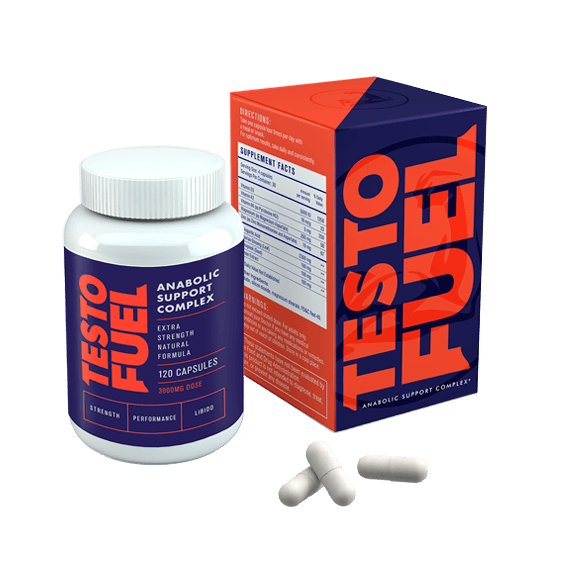How to Increase Testosterone Levels Naturally
Testosterone has a hand in almost every aspect of your life. From muscle mass and strength, through to mood and libido, T touches it all. As a result, you’re determined to improve yours.
But, can you do it without stepping into the murky world of illegal anabolic drugs? Yes – you’re going to start today too. Here’s your guide on how to increase testosterone levels naturally.
What is testosterone?
Once you learn what testosterone actually is, understanding how to increase it becomes easier.
In the simplest of terms, testosterone is a hormone responsible for masculine characteristics.
All mammals produce it, with the male of the species having the most – sometimes ten times more, in fact.
But there’s so much more to the potent androgenic hormones than assertiveness, sex drive, and hulking muscles. We’ll dive deeper into the full intricacies of T a little later.
Normal testosterone levels for men typically range between 300-1000 ng.dL. You have some small levels of T from birth, but once you hit puberty, production takes a steep surge upward until it hits a peak around age 19.
There’s a high chance you probably remember how strong, virile, and full of life you felt at then. Remembering the feeling reminds you of how powerful thriving testosterone can be. It touches almost every corner of your wellbeing from your teens until old age.
Read more about what testosterone is in our detailed guide.
Why is testosterone important?
A lot of men are shocked when they find out just how intrinsic testosterone is to their health.
It’s by far the most important hormone in your body, having a role in an impressive list of functions, some of which you might never even think of.
Who knew T played a part in energy by promoting red blood cell production? How about its connection to low mood, anxiety, and depression?
Yes – even your mental health can take a cue or two from testosterone.
Maintaining this healthy hormone creates an environment for you to live your best life. You’re stronger, fitter, happier and your risk of disease falls dramatically[1][2][3][4][5].
Looking after your testosterone is important for all adults, more-so if the miles are adding up in older age.
Here’s an expansive list of testosterone’s functions[6]:
- Muscle growth and strength
- Bone growth and density
- Fat distribution
- Cognitive function
- Mood
- Assertiveness
- Sexual function
- Sperm quality and fertility
- Red blood cell production (energy)
Low testosterone in men
Low testosterone – aka hypogonadism – is a growing concern among modern men.
Recent evidence even shows the testosterone surging (or simmering) under our skin doesn’t quite match up to our forefather’s when they were our age[7][8].
Apparently, our stressful 21st century lifestyles, filled with cramped office cubicles, dark commutes, Netflix-lit couch sessions and fast food have a lot to answer for.
Earlier we saw how normal testosterone levels can vary dramatically. When they drop below the 300 ng.dL baseline, however, they’re then considered low.
Age is an inevitable driving force behind testosterone deficiency, but disease and lifestyle can also play a part too.
T starts a natural decline in most men around age 30. It then descends at about one percent per year, and by the time you’re 80, your total testosterone may have halved.
Symptoms of low testosterone include[9]:
- Muscle loss
- Low libido
- Impaired sexual function/ED
- Infertility
- Irritability
- Brain fog
- Frailty/weakness
- Reduced energy
- Low mood
- Depression
- Anxiety
- Increased risk of heart attacks and stroke
- Increased risk of diabetes and metabolic disorder
The symptoms of low testosterone can have considerable impact on your wellbeing. Take yourself for a doctor’s blood test if you spot any.
7 ways to increase testosterone levels naturally
It can come as a surprise to some men when they learn it’s possible to increase testosterone naturally. But when you start to look at the science, it all makes perfect sense.
Your hormones are a product of their environment, which puts you in a position of control. You might not be able to stop father time or certain diseases – but you can create a better environment for T to succeed.
Below are seven steps to boost your testosterone naturally, without the need for a needle. First, let’s look at the power of lifting.
1. Lift weights
Exercise is a fundamental part of any healthy lifestyle. So much so, that one study from 2012 discovered that men who exercise regularly typically have higher testosterone levels than sedentary types[10].
However, when it comes to hiking up your masculine hormones, not all workouts carry the same weight.
Lifting can be extremely beneficial for maxing-out testosterone production, especially compared to traditional, steady state cardio.
Evidence points towards potential increases in a short-term post-lifting session spike, as well as long-term adaptations throughout a training program.
Simply put, weightlifting can help you boost testosterone today and for the foreseeable future. So long as you keep training and don’t overdo it, that is.
One study saw that both men and women experienced an increase in urinary steroid hormone levels after an acute training phase – aka as little as a single session[11].
Therefore, you could technically boost testosterone with one trip to the gym, but your levels won’t stay elevated that way for long – so consistency is key.
Another study investigating the impact of an eight-week training regime saw that testosterone levels took an upward trajectory during all points measured[12].
In short, they kept increasing throughout the two months they were tested.
We recommend hiring a personal trainer to write you a tailored periodized plan if you’re new to lifting. Long term consistency always beats short term intensity, so strap up and stick with it!
2. Try HIIT
High-intensity interval training (HIIT) has really stolen the limelight in recent years.
A favorite among time strapped gym goers and non-cardio fans alike, studies into short bursts of hard, intense exercise show you don’t have to spend hours on the treadmill to see results[13][14][15].
You can squeeze out a leaner physique and stronger cardiovascular system in as little as 10- to 30-minutes! Don’t mistake fast for easy though. It’s called high-intensity interval training for a reason.
Some research suggests that replacing your regular cardio with HIIT could hike up testosterone levels in men[16].
In one study from 2012, trained men followed a protocol of 90-seconds of treadmill running at 100%-110% maximal oxygen capacity followed by-90 seconds rest, for a total of 42-47 minutes.
On a separate occasion, the same men were asked to complete a steady-state endurance running session at 60-65% maximum capacity for 45 minutes.
Researchers then compared how each session impacted the test subject’s testosterone levels. According to their findings, intense training produced a more pronounced turnover of free testosterone compared to the slower steady state training sessions[17].
Bottom line – try HIIT to naturally hike up T.
3. Lose weight
It’s estimated that obese men have 30% lower testosterone on average compared to their healthier-weight peers[18].
If you’re overweight and want to naturally increase your T, it may help to drop a few pounds first – especially around your beltline.
Belly fat is a silent killer of testosterone. Its cells are packed with aromatase, an enzyme that converts masculine testosterone into feminine estrogen, which is the exact opposite of what you’re trying to achieve.
It should come as no surprise that obese men have higher levels of estrogen and over 70% of them suffer from testosterone deficiency[19].
Interestingly, one study saw that when obese men lift heavy weights, they might actually increase their testosterone more than if they lost weight alone[20].
So, we recommend combining the two. Hit the gym, lift heavy, stay consistent and stick to a well-balanced diet to see the best results.
4. Eat a well-balanced diet
Leading on from the idea of losing weight, we’re urging you to eat a well-balanced diet.
Testosterone is a product of its environment and what you put into your body has a huge influence on production.
First of all, you should make sure you’re not skipping your healthy fats, regardless of what TV diet doctors say.
Cholesterol is absolutely essential for testosterone synthetization and studies even show low-fat diets can contribute to sex hormone deficiency in men[21][22][23][24].
Stick to healthy lipids such as organ meat, eggs, fatty fish, and avocado over hydrogenated trans-fats. One simple rule is to stay natural and avoid processed.
Carbs and protein play a part in keeping testosterone healthy too. Research suggests that carbohydrates can help modulate testosterone during high-intensity resistance exercise[25].
Given that you’ll be lifting weights when following step one from earlier, carbs will have your hormone’s back when the reps get heavy.
Protein will also be there to support the building and maintenance of lean mass. Now, this is important, as muscle has a significantly higher metabolic demand than body fat.
The greater amount of lean muscle mass you have, the more calories it’ll need every day to function, which makes you less prone to overeating.
As a result, you may find it easier to maintain a healthy body composition, which in turn benefits testosterone production. You won’t be carrying around as much harmful estrogen-promoting belly fat either.
High-protein diets also appear to be one of the most effective eating methods for weight loss[26].
Protein has an incredibly high satiety rating to start, meaning it instigates hormone changes that help you feel fuller after eating[27][28][29].
Plus, protein is difficult for your body to break down. It’s one of the most thermogenic foods out there, with around 20-30% of its overall calories used just to process it[30].
Bottom line – eat all your macros for optimized testosterone.
5. Take the right supplements
Following on from step four, taking the right supplements can ensure a bulletproof nutrition plan.
Never intended to replace a well-balanced diet, supplements should be there to help cover all bases, supporting your hard work in the kitchen and filling in any unnoticed gaps. See supplements like your insurance plan or a booster for an already solid diet.
Studies have shown that certain testosterone booster supplements might prove beneficial if your testosterone is waning. While they’ll not offer the same power as full blown TRT, you could see some positive results.
Zinc and vitamin D deficiency is rife among modern men, causing complications in T production as a reaction[31][32].
Fortunately, though, adding in a supplement containing zinc or vitamin D can replenish stores, and potentially rejuvenate lost testosterone levels[33][34][35].
Just know that you might not experience noticeable results if you’re already topped up with the essential macros.
D-Aspartic Acid has also shown a lot of promise for testosterone deficient men. There’s evidence to suggest it could help boost T back to healthy levels, even increasing fertility and muscular hypertrophy along the way[36][37].
However, if your testosterone levels are normal, D-AA probably won’t improve them further. Healthy men who took D-AA only saw benefits in their strength and size gains, not hormones[38].
Ashwagandha, on the other hand, appears to promote healthier production in all kinds of men.
As an adaptogen, this ancient herb helps your body adapt to stress[39][40], which some experts say gives it testosterone boosting abilities by blocking cortisol.
Some studies suggest it might even improve fertility, muscle building, and fat loss too[41][42][43].
6. Get more quality sleep
When you want to squeeze every second out of day, sleep suffers. Testosterone follows suit too, which is something hardly any of us know about, never mind worry about.
If you’re notorious for stealing an extra hour or two to finish a project or binge Netflix, you might be doing more harm than good. Sleep deprivation is no joke and it actually kills productivity too – make a pact to quit.
Research looking at sleep deprivation shows that not meeting your seven to eight hours can ruthlessly cut testosterone production[44][45][46][47].
If you think your youthfulness is keeping you safe, one study saw significant impact even among the young[48].
Staying up and cutting back a high-quality night’s rest can be the same as aging 10-15 years in less than 24-hours!
Create the optimal sleeping environment by making your bedroom tidy and free from clutter. Set the temperate to cool and if possible, remove all sources of light.
It’s also well known that the blue light emitted from screens can throw off your natural circadian rhythm, so try to avoid electronic devices with screens an hour before bed.
Struggle getting to sleep no matter how many sheep you count? Try relaxation techniques like meditation, read a non-exciting book for half an hour, or hit the hay at the same time every single night, even if you’re not tired.
Many men find that they hit their stride with sleep once they stick to a routine – the brain loves predictability, even if you don’t.
7. Relax and de-stress
The body’s primal fight or flight response is inbuilt to keep you safe. You’re on high alert, your pulse quickens, and all your energy is directed to rescuing yourself from a potentially fatal situation.
There’s also an acute blast of cortisol, the stress hormone, into your bloodstream. When it comes to a life or death scenario – you’re ready to save yourself – even if it’s just an encroaching report deadline.
Now, the problem us men living in the third millennium have is our body doesn’t know the difference between an angry cave invader and a rude commuter who just cut you up in traffic. We’ve all being there and felt how hot headed it makes you feel.
When it perceives a threat, it perceives a threat – no discrimination. Every time you become stressed, your fight or flight response kick in and you have the immediate release of cortisol.
Get amped up every day – even about little things – and your elevated cortisol levels become chronic. This can be disastrous for your hormone balance.
Testosterone and cortisol can’t coinhabit the same space. They work in a see-saw effect, with one falling, while the other increases.
So, if you’re constantly stressed, you’re consistently putting a dampener on your testosterone. Research suggests cortisol could block T’s effects[49].
Let this be your wake-up call to lower the load. Relax and unwind by making a conscious effort to reduce how much stress you let in your life. Remember, you’re the man in control here.
Try being more selfish with your time. Maybe rekindle a relaxing hobby you enjoy like a pick-up game of soccer, playing video games, or learning an instrument. Be confident enough to say no when you need to.
A big worry for a lot of us is how our new laid-back approach might impact work. But you don’t have to be lazy, you can just be assertive about your time and energy supply.
Not taking on every whim of your boss won’t end your career – if anything, they might respect your guts and gravitas.
At the end of it all, stress is one of the leading contributors to all-cause mortality in the western world[50][51].
Are tanked testosterone and an early grave really worth it?
The Bottom Line
You don’t always have to take TRT to increase testosterone levels naturally. Sometimes all it might take is a close look at your lifestyle and making the necessary adjustments.
If there’s one thing the research makes clear it’s this; diet, exercise, sleep, and stress are the four pillars of a healthy hormone balance.
Get your house in order here and you’re creating a rich eco-system for optimized testosterone.
You could technically start all seven of the steps above today. But, if you’re new to concepts like healthy eating and exercise, it can be easier to take things one at a time.
As the old saying goes, don’t try to run before you can walk.
Trying to spin too many plates at once only adds to the stress of daily life, and looking at the facts from step seven, you’re onto better pastures now.
Do things at your own pace and steadily introduce new lifestyle changes so you can turn them into health-promoting habits.
As always, feel free to get in touch with us if you have a question regarding anything we’ve covered. We’re on a mission to help modern men get the most out of their testosterone – starting with you.



